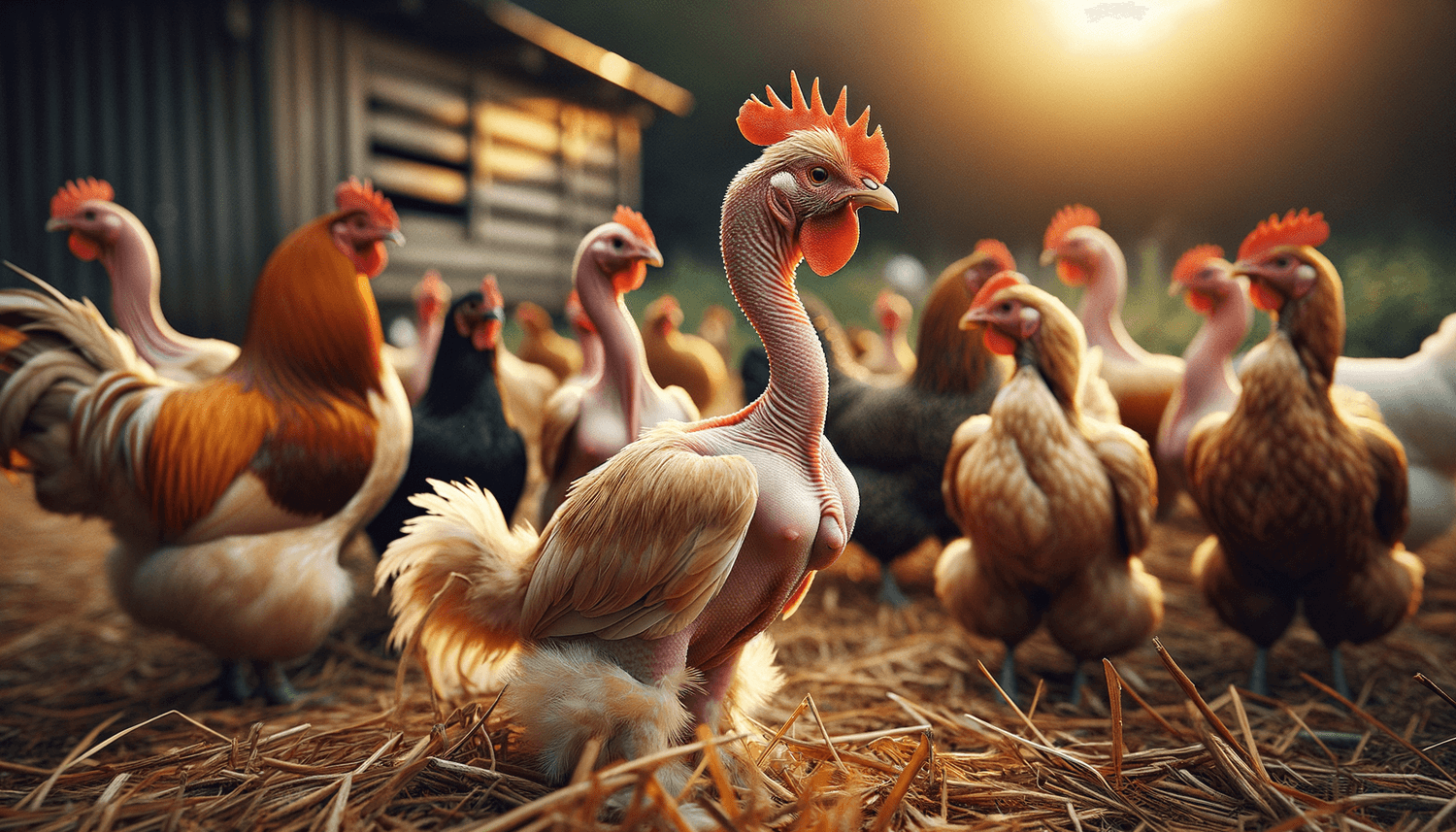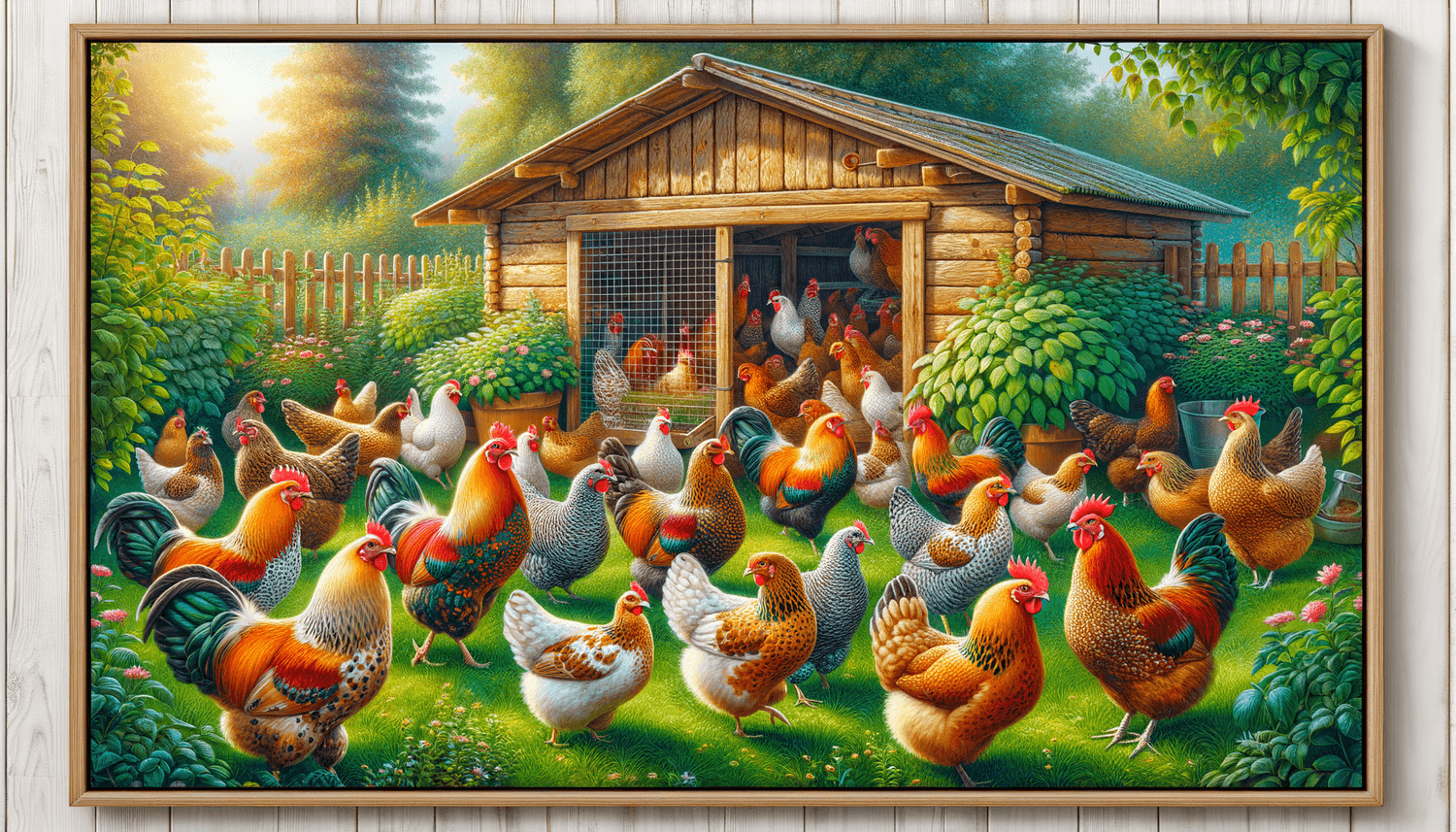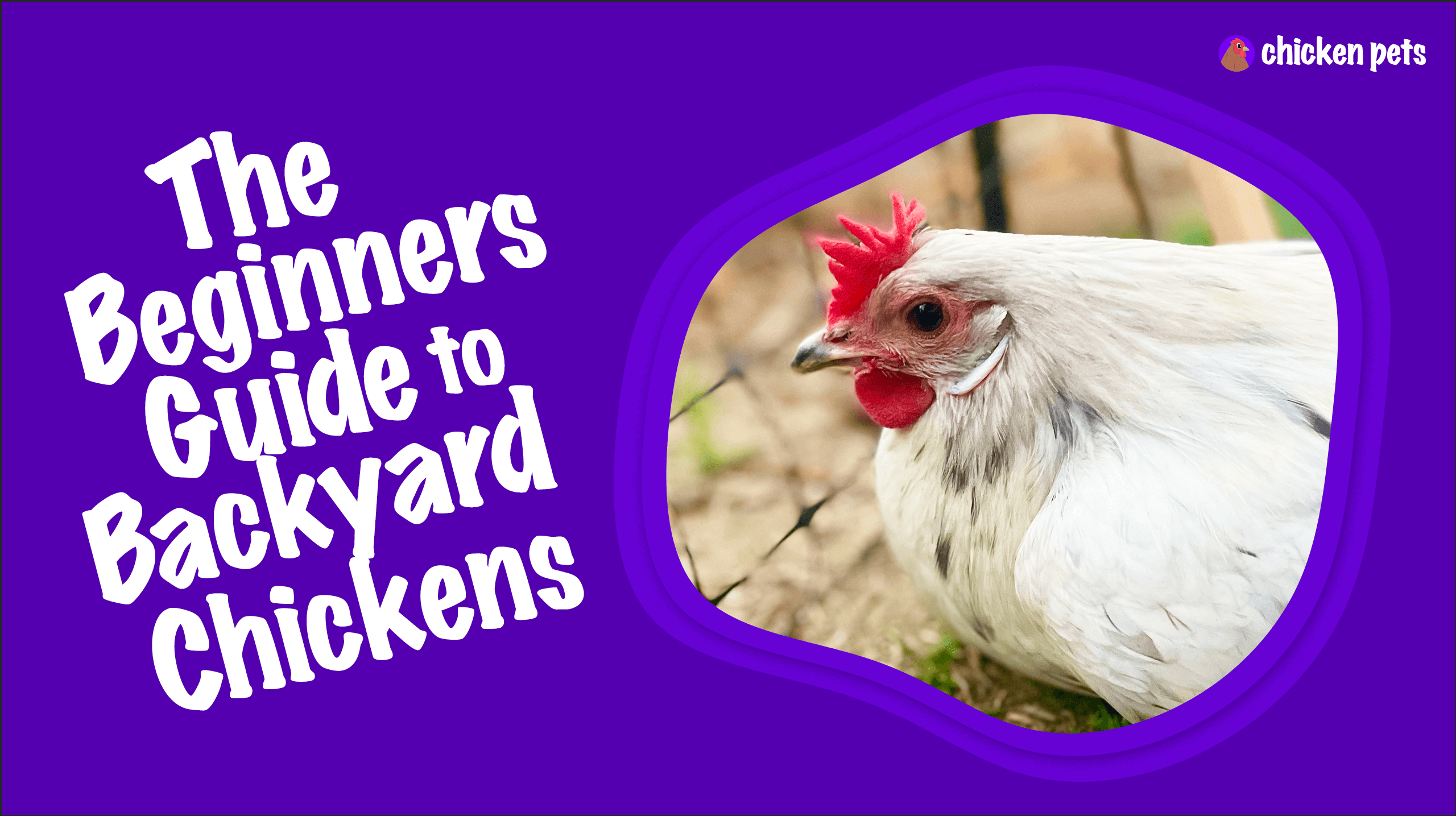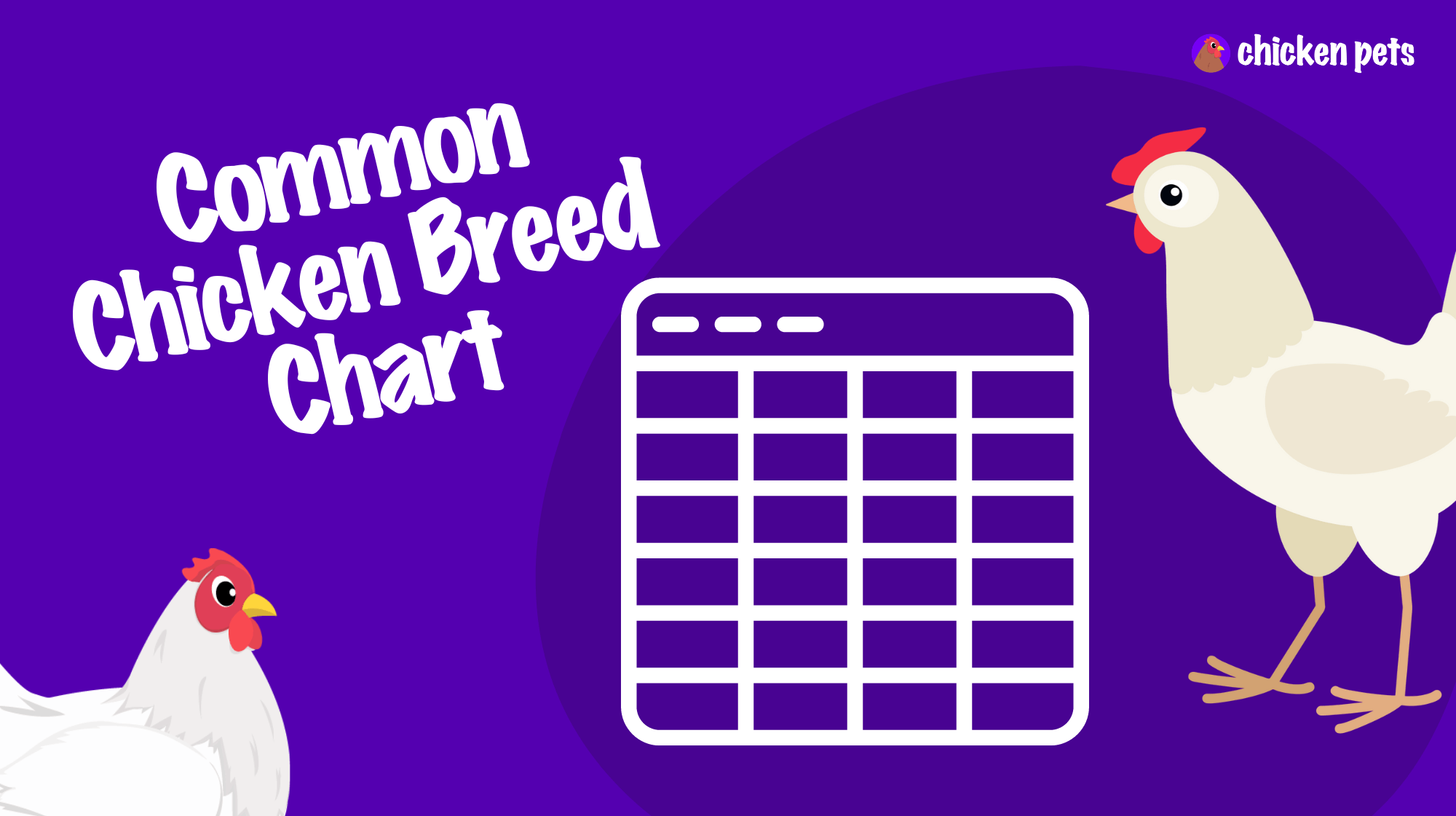Ever wondered about those peculiar chickens with featherless necks? Let’s dive into the world of chicken breeds with naked necks, learn what makes them so unique, and discover how to give these quirky birds the best care in your backyard flock!
Chicken Breeds with Naked Necks
Naked Neck chickens, also known as Transylvanian Naked Necks or Turken chickens, are distinctive due to their featherless necks. This unusual trait makes them adaptable to various climates and easier to care for, as they are less prone to overheating and parasites.
Characteristics of Naked Neck Chickens
Naked Neck chickens are easy to recognize because of their bare necks, but they also have other intriguing features that make them stand out. In this section, we’ll explore the physical and behavioral attributes that define these birds.
Physical Appearance
Aside from their featherless necks, Naked Neck chickens have a medium to large build, typically weighing six to eight pounds. Their feather coverage is similar to other chicken breeds but with less dense plumage. They come in various colors, including black, white, red, and blue. Their combs, wattles, and earlobes are red, giving these birds an eye-catching look.
Behavior and Temperament
Naked Neck chickens are known for their friendly, gentle, and calm nature. They are easily adaptable to various environments, making them perfect options for backyard chicken keepers with varying climates. These chickens are also relatively social and enjoy the company of other chickens and humans alike.
Caring for Naked Neck Chickens
Providing proper care is essential for your Naked Neck chickens to thrive in your backyard. While they share many requirements with other chicken breeds, there are a few specific considerations for these unique birds.
Shelter and Space
Like all chickens, Naked Necks need a safe, secure, and comfortable coop. The coop should have at least four square feet of space per bird to ensure they have enough room to move and keep their feathers clean. Place nesting boxes and roosts in the coop to provide them with a comfortable place to lay eggs and rest each night.
- Nesting boxes: One box for every four to five hens is ideal.
- Roosts: Provide about 8 to 10 inches of roost space per bird and place the roost at least 2 to 3 feet above the ground.
Outdoor Access
Naked Neck chickens are active birds that love to roam in the outdoors, so providing them with access to a secure, fenced yard or run is crucial. This will help them get the exercise they need and allow them to forage for insects and plants.
Feeding and Nutrition
Feed your Naked Neck chickens a complete, balanced diet to ensure they receive all the essential nutrients their bodies need. Layer feed, which contains enough protein, vitamins, and minerals, is ideal for laying hens.
- Pullets (young hens) require a feed containing 18-20% protein content.
- Laying hens require a feed with 16-18% protein content.
In addition to their feed, you can offer your chickens favorite treats like fruits, vegetables, and insects. Just keep in mind that treats should not make up more than 10% of their diet. Oyster shell or crushed eggshells can also be included to help with their calcium intake, essential for strong eggshells.
Temperature Considerations
One of the most significant advantages of Naked Neck chickens is their adaptability to various climates. This makes them an excellent option for both hot and cold weather conditions. However, it is still essential to ensure the comfort and safety of these unusual birds in extreme temperatures.
Hot Weather
While their reduced feather coverage makes them better suited for hot conditions, Naked Necks may still need some extra help to stay cool during the hotter months. Here are some ways to help them beat the heat:
- Provide plenty of shade in their outdoor area.
- Ensure they have constant access to clean, fresh water.
- Help alleviate heat build-up in the coop with proper ventilation.
Cold Weather
In colder climates, Naked Neck chickens’ featherless necks may make them more susceptible to frostbite. To prevent this, take the following steps:
- Insulate the coop to keep it warm and dry.
- Ensure proper ventilation to minimize moisture buildup.
- Check for drafts and seal any gaps to prevent cold air from entering the coop.
Breeding and Egg Production
Naked Neck chickens are dual-purpose birds, meaning they are suitable for both egg and meat production. If you are considering breeding these unique chickens, it’s essential to familiarize yourself with their egg-laying habits and fertility rates.
Egg Production
Naked Neck hens are considered good layers, producing about 150 to 200 large brown eggs per year. They tend to start laying eggs when they are between five and six months old. Keep in mind that factors such as nutrition, climate, and the individual bird’s genes can affect their egg production.
Breeding Naked Neck Chickens
If you decide to breed Naked Neck chickens, observe the following tips to increase the chances of a successful hatch:
- Select healthy, vigorous parent birds with desirable traits.
- Ensure a balanced diet for both hens and roosters.
- Collect eggs regularly and store them in a cool, dark place before incubation.
- Turn the eggs regularly during incubation to ensure proper embryo development.
It’s important to note that not all offspring from Naked Neck parents will have the naked neck trait. Breeding birds with this characteristic have about a 75% chance of producing chicks with naked necks.
Health and Potential Issues
While Naked Neck chickens are generally healthy and hardy birds, it’s crucial to be aware of potential health issues and understand how to address them to maintain a thriving flock.
Parasites
Fleas, lice, and mites are common external parasites that can infest your chickens. While Naked Necks’ bare skin may help reduce the likelihood of infestations, it’s still crucial to check your birds regularly for signs of these pests. Treat infestations promptly with approved parasite treatments.
Respiratory Illnesses
Respiratory illnesses are common in chickens and can lead to severe health issues if not caught and treated early. Look for signs like sneezing, coughing, wheezing, or discharge from the eyes or nose. Consult a veterinarian if you suspect a respiratory issue to ensure proper diagnosis and treatment.
Preventative Care
To keep your Naked Neck chickens in good health, practice good hygiene and management, including the following:
- Perform regular health checks on your birds, paying close attention to any changes in behavior or appearance.
- Keep their coop and surroundings clean, removing soiled bedding and replacing it with clean, dry material.
- Provide a balanced diet and access to clean, fresh water at all times.
- Keep an eye out for potential predators to protect your flock.
By staying informed about Naked Neck chickens’ unique characteristics, care requirements, and potential health issues, you can confidently add these unusual birds to your backyard flock. Enjoy the experience of raising and caring for these distinctive, friendly creatures, and reap the rewards of their egg and meat production for years to come.
Broodiness and Raising Chicks
Naked Neck chickens have a medium level of broodiness, meaning that some hens may show a strong desire to sit on their eggs and raise chicks. If you plan on raising chicks from this breed or have a broody hen, these tips can help you support your birds during this process.
Creating a Safe Space for the Broody Hen
When a hen becomes broody, she will want a safe, secluded spot to lay her eggs and keep them warm. Provide a nesting box with enough room for the hen to sit comfortably on her eggs. A comfortable nesting area can also increase the chances of a successful hatch.
Caring for the Broody Hen
A broody hen requires proper care and nutrition to ensure her health and her chicks’ success. Here’s how you can care for her:
- Monitor her food and water intake daily.
- Offer her high-protein feed to support chick development and her own well-being.
- Keep her nesting area clean and dry, replacing soiled bedding as needed.
Raising Naked Neck Chicks
Whether you allow your broody hen to raise her chicks or you’re raising chicks in a brooder, it’s essential to provide them with all they need during the first few weeks of life:
- Provide heat with a heat lamp or heating plate, aiming for a temperature of 95°F (35°C) during the first week, and reduce the temperature by 5°F (3°C) until it reaches room temperature.
- Offer chick starter feed, which has a higher protein content than adult chicken feed, and ensure fresh water is always available.
- Maintain a clean brooder, replacing soiled bedding regularly to prevent disease.
- Introduce the chicks to the rest of the flock carefully and gradually, once they are fully feathered and have grown accustomed to outdoor temperatures.
Adding Naked Neck Chickens to Your Existing Flock
If you’re considering adding Naked Neck chickens to your existing flock, it’s essential to know how to introduce them properly. Following these steps can help ensure a seamless integration and reduce the chances of aggressive behavior or pecking order disputes.
Quarantine New Birds
Start by quarantining the new Naked Neck chickens away from your existing flock for two to four weeks. This helps prevent the spread of any unnoticed illnesses or parasites.
Gradual Introduction
Once the quarantine period is over, you can introduce the new birds to your existing flock gradually. Start by putting them in a separate but visible enclosures so they can see and interact with each other without physical contact.
Supervised Interaction
After a week or two of seeing each other, you can allow supervised direct contact between the new and old birds. Start with short periods and keep an eye out for any aggressive behavior. Gradually increase the interaction time, making sure they get used to sharing the same space.
Integration
Once all the birds appear to be getting along, you can finally let them share the same coop and living space. Supervise the initial days to make sure the flock has fully adapted to their new members.
Adding Naked Neck chickens to your backyard flock can be a rewarding experience, both for their unique appearance and their adaptability to various climates. By being mindful of their distinct needs and providing good care, you can successfully raise and integrate these chickens into your existing flock.
Frequently Asked Questions
In this FAQ section, we will address some common questions related to raising and caring for Naked Neck chickens. This should give you a better understanding of their unique features and their ideal care requirements.
1. Are Naked Neck chickens friendly?
Yes, Naked Neck chickens are known for their friendly, gentle, and calm nature. They are relatively social and enjoy the company of other chickens and humans alike.
2. How many eggs do Naked Neck chickens lay per year?
Naked Neck hens are considered good layers, producing about 150 to 200 large brown eggs per year.
3. When do Naked Neck hens start laying eggs?
Naked Neck hens typically start laying eggs when they are between five and six months old.
4. Are Naked Neck chickens good for meat production?
Yes, Naked Neck chickens are dual-purpose birds, meaning they are suitable for both egg and meat production.
5. Can Naked Neck chickens tolerate both hot and cold climates?
Yes, Naked Neck chickens are adaptable to various climates, making them an excellent option for both hot and cold weather conditions. However, it’s still essential to ensure their comfort and safety in extreme temperatures.
6. What should I feed my Naked Neck chickens?
Feed your Naked Neck chickens a complete, balanced diet. Layer feed, which contains enough protein, vitamins, and minerals, is ideal for laying hens. Pullets require a feed containing 18-20% protein content, while laying hens require a feed with 16-18% protein content.
7. What type of shelter and space do Naked Neck chickens need?
Naked Neck chickens need a safe, secure, and comfortable coop with at least four square feet of space per bird. Place nesting boxes and roosts in the coop, providing one nesting box for every four to five hens and about 8 to 10 inches of roost space per bird.
8. Can I raise Naked Neck chicks with other breeds?
Yes, you can raise Naked Neck chicks with other breeds, as long as all the birds are introduced and integrated properly into your existing flock.
9. How can I increase the chances of a successful hatch when breeding Naked Necks?
Select healthy parent birds with desirable traits, ensure a balanced diet for both hens and roosters, collect eggs regularly and store them in a cool, dark place before incubation, and turn the eggs regularly during incubation to ensure proper embryo development.
10. How often should I check my Naked Necks for parasites?
Perform regular health checks on your birds, ideally at least monthly, and pay close attention to their skin and feathers for signs of fleas, lice, and mites. Treat infestations promptly with approved parasite treatments.
11. What are some common respiratory illnesses in Naked Neck chickens?
Some common respiratory illnesses in chickens include infectious bronchitis, mycoplasma gallisepticum, and infectious laryngotracheitis. Look for signs like sneezing, coughing, wheezing, or discharge from the eyes or nose, and consult a veterinarian if you suspect a respiratory issue.
12. How can I prevent frostbite on my Naked Neck chickens in cold weather?
Insulate the coop to keep it warm and dry, ensure proper ventilation to minimize moisture buildup, and check for drafts and seal any gaps to prevent cold air from entering the coop.
13. How do I introduce Naked Neck chickens to my existing flock?
Quarantine new birds for two to four weeks, then gradually introduce them to the existing flock by putting them in a separate but visible enclosures. Allow supervised direct contact between the new and old birds, and once they are getting along, let them share the same coop and living space.

















